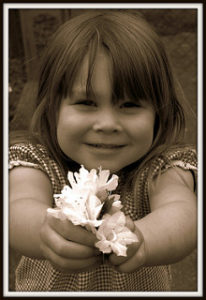
This is part of a series, introduced in Baby Steps, about arts organizations’ initial efforts in community engagement. For details about the premises upon which these posts are based, see below. The essence is that simple, inexpensive initial steps offer the best way to embark upon community engagement.
Present What You Do: Connecting through Our Art
The most important attribute of any arts organization is, of course, the art it presents. To many people, committing to community engagement raises images (and fears) of rapid, monumental, systemic change. While significant change may result eventually–but only after the organization and the communities it is attempting to reach are both ready–there is much that can be done with little or no change to currently offered programming.
Ours is an event-driven, action-oriented industry. When we commit to a new way of thinking we want to do. But premature “doing”–programming without real knowledge of or input from a community–can feel invasive to them. It can also be viewed as a simple ploy to sell tickets or secure grant funds. This will do nothing to build trust and develop relationships.
Fortunately, the first step for most arts organizations should simply be imagining what currently scheduled performances or exhibitions might look like to communities they hope to reach. My overused example of West Side Story as tale of immigrant conflict and gang violence is a case in point. Most cities have issues with both. Being aware of the themes, background, or history of the works presented and of the interests of local communities can provide flashes of insight into ways to connect.
Of course if those flashes involve communities with which no relationship currently exists, there is a very real danger that approaching them will appear self-serving. A public commitment to relationship building, respect, and mutual benefit could help to pave the way. (See here for an example.) In addition, if there is no current relationship, there is no guarantee that the themes you identify will actually be meaningful to those communities. But making the effort, acknowledging the organization’s need to learn, is probably better than nothing.
Far better, of course, is having relationships and identifying themes that you know will be of significance to them. Relationship building, like pure scientific research, is intended to lay foundations upon which to build, not knowing what the end might be. And the relationship building should have higher success rates than pure research!
Over time, as relationships develop, selection of works to present can be informed by what is know about the communities with which you are working. These selections, especially in the beginning, can and probably should be of work that would have been presented anyway. The timing of the presentation will simply be helpful in deepening the relationship.
Only in the long term will it be beneficial to solicit community input on programming. This should not be taking a poll of “What they want.” Rather, knowing the issues that speak to them and that they would like to address, the arts organization can make suggestions about works that might serve those ends.
As I have said elsewhere, when arts organization staff members find themselves curious about whether their presentation of:
- Vivaldi’s The Four Seasons might serve the interests of their friends at the Sierra Club;
- Oliver (or a staging of Oliver Twist) might facilitate awareness of homeless families and children;
- Appalachian Spring would be useful to educators teaching U.S or (depending on the city involved) local history; or
- An exhibition of “outsider art” could help illuminate issues of power and privilege or insider/outsider status,
they have developed a habit of mind that can fuel successful engagement.
The principal point here is that much can be done with little or no change to currently scheduled programming or with little change in the approaches to future programming. The important thing is to begin.
Engage!
Doug
Photo: ![]() Some rights reserved by downing.amanda
Some rights reserved by downing.amanda
The premises of this blog series are twofold. First, since relationship building is the core of community engagement, attempting to do too much too fast (before the relationship is established) will likely not be productive and, in fact, may be counter-productive. Second, there are many things that can be done to support engagement that do not require new personnel or new budgets. Simply re-imagining (and perhaps slightly re-tooling) things that are already being done can support engagement in very effective ways.
It should go without saying that the core of all engagement work is a strong (even if not unanimous) desire on the part of the organization to make connections with new communities. If the will to do so is lacking, the work will be at best minimally successful.

[…] Present What You Do The most important attribute of any arts organization is, of course, the art it presents. To many people, committing to community engagement raises images (and fears) of rapid, monumental, systemic change. While significant change may result eventually … there is much that can be done with little or no change to currently offered programming. … read more AJBlog: Engaging Matters Published 2018-02-06 Artists as speculators A new working paper from Amy Whitaker and Roman Kräussl suggests a new model of finance for visual artists. … new TWTR.Widget({ version: 2, type: 'profile', rpp: 7, interval: 30000, width: 'auto', height: 300, theme: { shell: { background: '#8dc0da', color: '#ffffff' }, tweets: { background: '#ffffff', color: '#000000', links: '#8dc0da' } }, features: { scrollbar: true, loop: true, live: false, behavior: 'default' } }).render().setUser('britishnewscld').start(); BBC Radio 1 click here Cool FM 97.4Newtownards, Northern Ireland click here Business ScotlandEdinburgh, Scotland click here News Talk 106.0 FMDublin, Ireland click here Central WalesCardiff, Wales click here Free RadioBirmingham, UK click here Manchester Radio OnlineManchester, UK click here Radio City 96.7Liverpool, UK click here […]